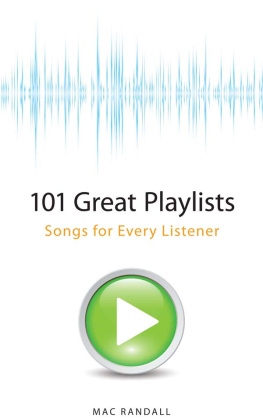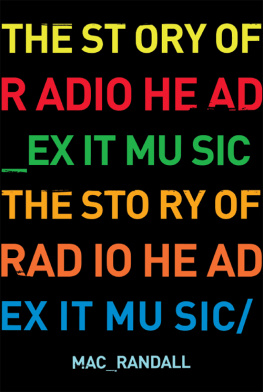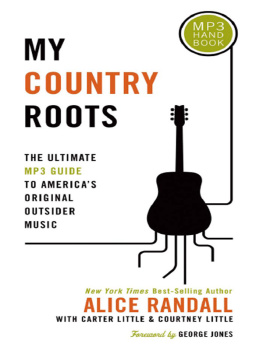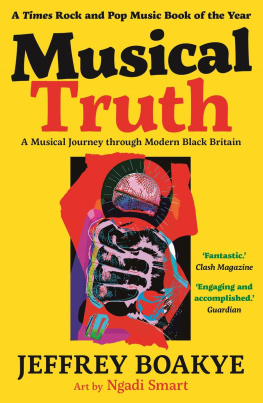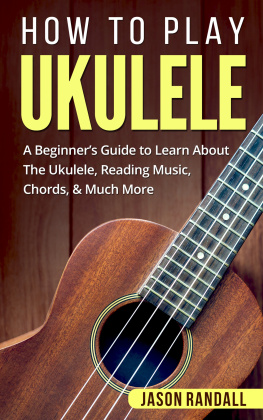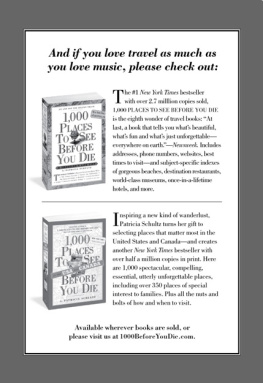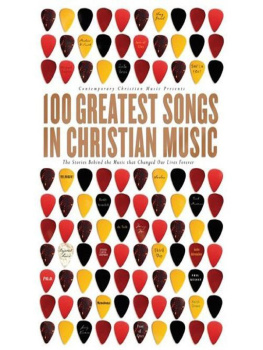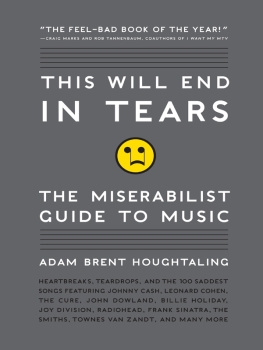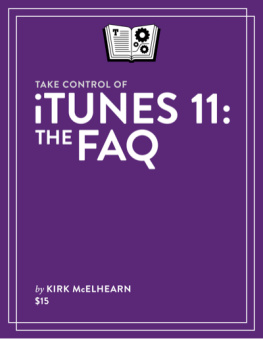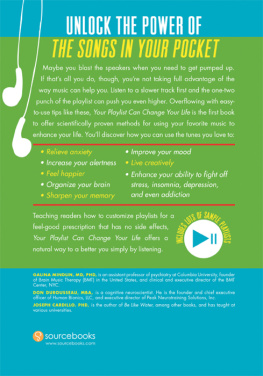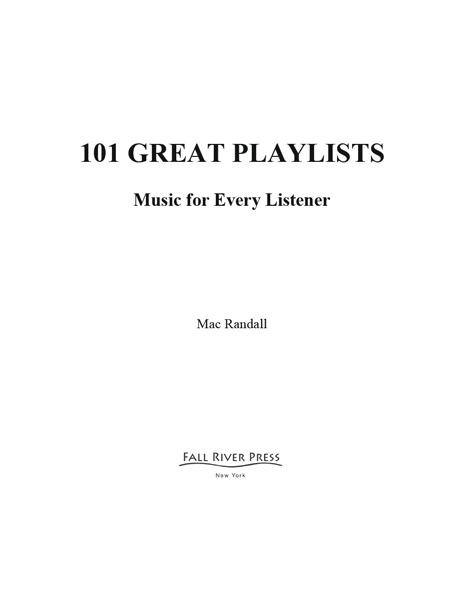

FALL RIVER PRESS and the distinctive Fall River Press logo are registered trademarks of Barnes & Noble,Inc.
2012 by Fall River Press
All rights reserved. No part of this publication may be reproduced, stored in a retrieval system, or transmitted, in any form or by any means, electronic, mechanical, photocopying, recording, or otherwise, without prior written permission from the publisher.
ISBN 978-1-4351-4298-5(ebook)
First edition
www.sterlingpublishing.com
So much of the joy of music lies in the thrill of discovery. The first time you heard a song that would eventually become your favorite. The first time you realized, Hey, thats who sings that one! The first time you understood all the words correctly. The first time you made a connection between one band, one composer, or one player and another. The first time you listened to something that didnt sound like anything else youd heard before.
For me, the discovery process began with classical music. At first, when I was about five years old, I gravitated toward kid-friendly programmatic pieces: The Sorcerers Apprentice by Dukas, Rimsky-Korsakovs Scheherazade, Saint-Sanss Carnival of the Animals, Prokofievs Peter and the Wolf. Then, with the help of my parents record collection, I moved into true old-warhorse territory. I wore down the grooves on recordings of Mozarts 40th, Schuberts Unfinished, the odd-numbered Beethoven symphonies, the Tchaikovsky ballets, Eugene Ormandys transcriptions of Bach for the Philadelphia Orchestra. Wearing a homemade mask and a blanket around my shoulders that served as a cape, Id frantically mime to the playing of Vladimir Horowitz as he tore his way through Scriabins almost absurdly dramatic tude in Dsharp Minor. I was, as the Brits say, mad for it.
Next, when I was seven or so, came musicals. There were several original Broadway cast albums in the house along with the classical stuff, and I marveled at the melodic and lyrical intricacies of West Side Story, Guys and Dolls, South Pacific, and especially My Fair Lady. Sometimes I had next to no idea what Rex Harrison was singspeaking about, yet the wordplay entranced me. And then there was the brilliant closing gambit, Ive Grown Accustomed to Her Face, which needed no explanation. I still believe its one of the most beautifully understated love songs of all time.
By this point, my mom and dad had started trying to interest me in more modern popular music, but I resisted. Maybe Id already begun to take on the teenagers mistrust of anything ones parents might recommend. Or maybe I just wasnt ready. But I finally came around, in a big way, on the evening of December 25, 1980. I was eight. Jean and Arthur Bennett, close friends of my family, bought me the Beatles Sgt. Peppers Lonely Hearts Club Band for Christmas, and they gave it to me while we were visiting their home in New Bedford, Massachusetts, in the middle of a crowded holiday party. Because the album cover was so colorful and fascinating, I wanted to listen to it right away, so I put it on their turntable and listened through a heavy set of headphones (I wouldnt have been able to hear the music over all the talking in the house otherwise).
The next 40 minutes or so are perfectly clear in my memory. As I listened to this music for the first timemusic that still boggles my mind more than 30 years laterI looked across the room at the lights of the Bennetts Christmas tree, and at their reflections in the window nearby, a chain of multicolored stars that seemed to hover above the playing field across the street. I could almost have sworn that those reflections were beginning to spin around, a kaleidoscope to match the words and sounds whirling through my ears. I now know that the songs I loved most then were (mostly) John Lennons: Lucy in the Sky with Diamonds, Being for the Benefit of Mr. Kite, Good Morning Good Morning, A Day in the Life. George Harrisons Within You Without You also dazzled me, especially the East-meets-West part in the middle, where the sitar and the orchestra trade licks. I hadnt a clue what a sitar was then, but that didnt matter. All that mattered was that it sounded fantastic.
Over the next six months, I spent all my weekly allowance on Beatles records and listened to nothing else. Then I started investigating the four Beatles solo work. Before long, I was checking out other British Invasion bands of the same era: the Rolling Stones, the Who, the Kinks, the Yardbirds. Somewhere in there, I also noticed another album on my dads shelf called Monks Dream, by a fellow with the curious name of Thelonious Monk; its joyful dissonance made me laugh, winning me over instantly and introducing me to jazz. Eventually, I even started listening to the radio and catching up on the pop music of my own time, including Hall & Oates, the J. Geils Band, Thomas Dolby, and the Lindsey Buckingham/Stevie Nicks-era Fleetwood Mac. If it hadnt already been clear for years, it was certainly clear now: I was a music freak.
The depth of my interest only grew as I got older. I took guitar lessons so I could play my favorite songs myself, and so I could better understand what made those songs so good in the first place. I devoured record guides and music encyclopedias. And I made lists. Lots of lists. In the summer of 1987, the 100 Best Albums of the Past 20 Years issue of Rolling Stone became my bible; I took careful note of which albums I had and which I didnt. When I bought a new album, Id move it from the wanted list to the purchased listand just for kicks, Id write a review of it for an imaginary magazine.
Looking back on all this now, its really no surprise that I ended up writing about music for a living. That thrill of discovery was something I wanted to keep feeling again and again. And it was something that I wanted to help other people feel too.
Thats where this book comes in. Its sole purpose is to aid you in making your own musical discoveries. These days, of course, finding music isnt nearly as involved a process as it was when I was a kid. Forget about the turntables, the bulky headphones, the reference books, the magazines, and the record stores; thanks to the Internet and digital audio technology, you can track down and hear just about any track from the past century of recorded music with relative ease. But along with this enviable ability comes option anxiety. If you can listen to everything, then why listen to anything? What Ive provided here is a rough framework that will, I hope, at least begin to answer that question.
The structure is simple: 101 playlists of 10 to 25 tracks each, divided into three groups. The first group focuses on genres, the second looks at specific individuals and their influence, and the third deals with concepts (moods, common sounds, lyrical themes, musical features, geographic areas, and so forth). There is, of course, a certain degree of overlap among the three categories. Each group of playlists ends with a palate cleanser that serves as both the closing punctuation and the cooldown to a serious aural workout. Although Ive spent a fair amount of time determining the order both of the playlists and the tracks within them, I encourage you to disregard them if you so choose. We live in a shuffle culture, and we may as well embrace that. Similarly, in most cases I offer no guidance as to where these tracks are located. Unless Ive included specific sources for songs, the alternate take you hear on Rhapsody or the live video you find on YouTube will do the job just as well as the official studio recording.
Next page
